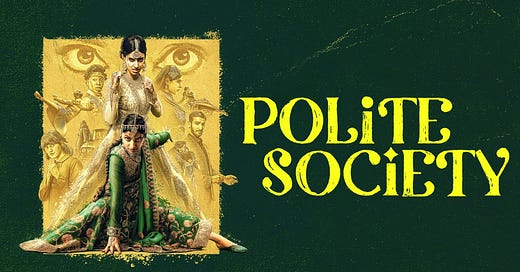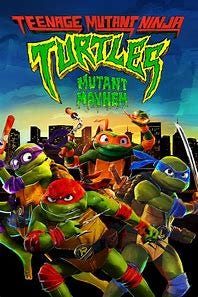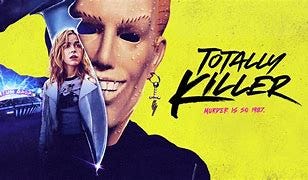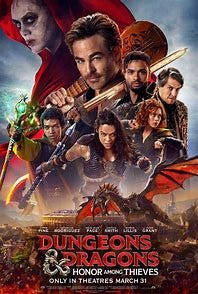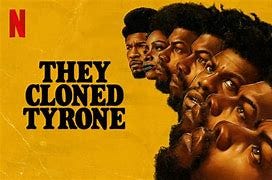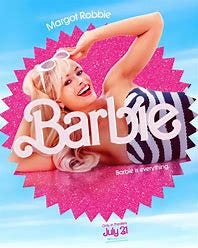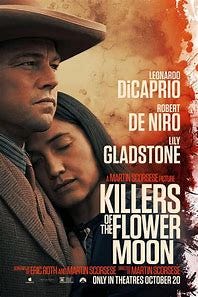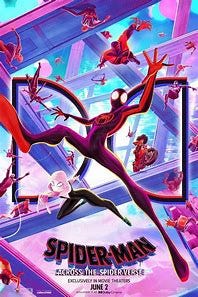SPOILERS AHEAD
SPOILERS AHEAD
SPOILERS AHEAD
SPOILERS AHEAD
SPOILERS AHEAD
In case you didn’t get the message, I will probably talk about plot points in all of these. If you see a movie poster and don’t want to see a spoiler? I would recommend moving on to the next poster. If you don’t mind spoilers, read on. Also, I still need to see The Boy and the Heron, Oppenheimer, Bottoms and Infinity Pool.
10. Tetris - I watched this in the comfort of my own home. I was surprised how much I enjoyed it. Taron Egerton never plays someone I like, but he is very good at it. Tetris dives deeply into the history of how Tetris came to exist in the world and one man’s journey to fighting incompetence and the pratfalls of Capitalism to get a game made.
There’s a bit of pro-USA sheen on this movie, especially with a made up chase sequence at the end of the film that detracted far more than it added, but the bits that focused on Henk Rogers, the Dutch video game developer who helped Alexey Pajitnov, the actual designer of Tetris, bring the game to the masses. Much like all biopics around success, there’s a heavy emphasis on the financial windfall. But the bureaucracy and incompetence of businessmen felt very real and showed just how dangerous it is to put our faith in any establishment that rewards being self serving.
It was fun and definitely played up parts for dramatic effect, but I am glad I saw it and Egerton continues to surprise me as an actor.
TMNT: Mutant Mayhem - Listen, I love the Ninja Turtles. That was my property as a kid. I loved the show, the movies, the comics, all of it. The only thing I liked more was Jurassic Park and X-Men. Maybe Batman, but I think TMNT took the cake. I’ve seen every reboot, even tried with some of the bad Nickelodeon shows.
I couldn’t do it. But Seth Rogen got involved and he’s been pretty spot on with comic adaptations. The art was heavily influenced by Into the Spider-verse. The voice actors were actually teenagers. It was paying homage to the vast, deep lore of TMNT.
This movie goes wrong in a few places that keep it from the top tier TMNT incarnations. The teenaged April O’Neal was fantastic but her connection to the turtles was so by the numbers it hurt. Where they dared to be so bold in the character development, they fell flat on the plotting. And, the movie drowns under the weight of too many villains that never get adequate development.
The intergenerational stories also really didn’t work. Neither Splinter with the turtles nor Ice Cube’s Baxter Stockman SuperFly.
There are some truly touching moments, like when the Turtles bond with “evil” Mutants at a bar before the inevitable facedown. April getting to know the turtles. An amazing sequence where the five meet for the first time, one of the coolest in modern American animation.
The messaging is mostly positive, addressing othering, bullying and friendship. But I wish they hadn’t played it so safe. Overall, a good film with some of the best interpretations of the characters ever. Just give them some space and a better story to work with.
John Wick Chapter 4 - Keanu has redefined the American Action Movie again. John Wick 4 was the best one since the first. The fight choreography remains some of the best in the West. John Wick has grown outside the trappings of believable action so much that this is far more fantasy, an American wuxia film that adapts so well to American Gun movies.
Some world building that takes a bit of the worst nonsense from the last two films and really pays off. John Wick is taking on the entire world of assassins, complete with a full blown homage to Zatoichi. It’s one of the best takes on a martial arts classic and it doesn’t hurt that Donnie Yen is taking up the reins. Wick vs Caine is an all-timer fight with a well earned payoff. American action movies fell into bad buddy cop comedies with over the top explosions and terrible choreography in the 80s and that morphed into bland super hero tropes.
Reeves has been a part of two of the biggest influences on modern American action cinema. While the Matrix’ bullet time remains mind blowing, and Matt Damon’s Bourne-esque frenzied, kinetic slowdowns seems to still dominate a lot of action sets, John Wick is the most consistently excellent fight staging in American film. I’m hopeful it will lead to a focus on the fight choreography and less on the cinematography going forward.
John Wick: Chapter 4 finds the titular hero waging war on the entire assassin establishment itself. After his allies are ex-communicated for aligning with Persona non Grata numbero uno, Wick gets back into his Russian Crime Family to duel for the rights of his entire posse to be restored. Bill Skarsgard stars as the Marquis hellbent on bringing the rogue Wick to heel. None of the plot points will surprise anyone who has seen martial art or westerns movies, but it does treat them with reverence that rarely gets tacky.
Rina Sawayama’s origin story as the blade wielding Akira was also a standout subplot that helps build the world of John Wick in a much more compelling way than some of the earlier attempts. John Wick films work best when they focus on the smaller stories.
Totally Killer - We watched this right after Renfield and what a wild pendulum swing that was across ostensibly the same genre. Both are horror/comedies, but Renfield almost felt like a relic. A style of movie that felt stale as soon as it hit the scene, but Renfield would have fit in well with the Brothers Grimm/Van Helsing era.
Totally Killer, on the other hand, was very current. A heavy dose of Gen X nostalgia in the form of the Back to the Future meets Friday the 13th plotting, coupled with Gen X sitcom favorite Julie Bowen clashing with Zoomer daughter Kiernan Shipka works way more than it does on paper. It is funnier than it has any right to be and it mines the pathos of meeting your teenage parents much deeper than BTTF ever did.
Shipka’s Jamie Hughes is the daughter of Bowen’s Pam Hughes (nee Miller). Pam is the sole survivor of a group of teenagers who were stabbed to death in 1987. The killer returns and Jamie narrowly escapes with her life due to her best friend’s time machine being stabbed by the killer’s knife. She shows up right before the killings start and tries to rewrite history.
She has to balance keeping her parents from getting together too soon with trying to keep people from dying and figuring out who the killer is as the murders were never solved and her mother was murdered in a similar fashion right before the killer tried to get her. That’s a lot to take in, especially when your mother isn’t the person she grew up to be. She also has to figure out how to get back home and she doesn’t have Doc Brown. She does, however, have her best friend’s mother. The person who started to figure out time travel before she gave up.
The twisty turny elements of the plot, which are resolved during a ridiculously over the top Gravitron set piece (nice Strangers on a Train touch), get too ridiculous by the end of the film. This isn’t quite a horror/comedy classic, but it is worth watching and I could see it having legs for a long time.
Dungeons & Dragons: Honor Among Thieves - Is this a mainstream action/comedy? Yes. Is it also a loving overture to Dungeons & Dragons? You bet. Is it also a good film? Surprisingly so. Mainstream fantasy never had legs before Lord of the Rings. Some stuff found purchase, but it was mostly in the fringes like Willow or Labyrinth. Or the magic was toned down, like Spielberg’s hit or miss Hook.
LOTR's trilogy wasn’t what I wanted, but it kicked open the doors on what audiences would see. A huge commercial and critical success, fantasy was now on the table. Where Sci-Fi and Comics had always had mainstream appeal, Fantasy now had Legit Credentials. Oscars, box office records, spin-offs. Tolkien was cool.
Then George R.R. Martin’s A Song of Ice and Fire was adapted into Game of Thrones and fantasy was a bona fide success. D&D has long existed in the shadowy corners of the mainstream. Used for Christian Panic in the 80s. A pulpy, bad film in 2000’s Dungeons & Dragons which tells you what studio execs thought about one of the biggest fantasy franchises in the world. The animated show was also bad, but charming.
Creator Gary Gygax was a problematic person who was also hugely influential on the world of gaming. GenCon alone would be a massive legacy, but he was also the Stan Lee of table top gaming. Richard Garfield is probably the only other person who looms as large in the history of American tabletop gaming.
Stranger Things, a heavy bit of 80s nostalgia that traffics heavily in the fringe popular culture phenoms, spearheaded D&D finally shattering the barrier. A host of D&D media was now everywhere. Critical Role got a TV show. Baldur’s Gate 3, a revival of a beloved series, was greenlit. D&D crossovers were everywhere. How was Hollywood going to treat them this time?
Thankfully, much better. The story, a father seeking redemption for his past and confronting the negative forces in his daughter’s life, doesn’t tread any new ground. What it did do was weave so much of what makes D&D special into the fabric of the movie. Bardic Inspiration. Wild Magic Surges. Low Charisma Paladins.
The Players contriving a solution to a problem the DM was already solving, which itself was a great use of Character Introductions at the start of a campaign. In the opening sequence, Chris Pine’s bard Edgin Davis and Michelle Rodriguez’ barbarian Holga Kilgore are making a case for early release while telling you how they came to be here. Classic first session stuff integrated as a handy introduction for newcomers to the weird world of Faerun.
Lots of classic D&D experiences on full display, but the characters are well developed and most of the story beats land. Most campaigns end up treading familiar ground, so even that was a nice touch. Elements of a classic heist film drive the plot forward. They’ve got to get the band back together and figure out who betrayed them. Hugh Grant plays a scumbag, big shock. Sometimes a movie just needs to be good and this was a perfect big screen popcorn flick.
They Cloned Tyrone - Afrofuturism is currently a hotbed of creativity. From Attack the Block to Get Out to I’m Sorry to Bother You to Black Panther, the scene is churning out classics. Movies that use elements of Sci-Fi to speak to the black experience. There’s a subset of films that have been called hoodfuturism, dealing more specifically with inner-city black neighborhood life and culture.
They Cloned Tyrone is the blaxploitation take on the genre/sub-genre. Fontaine, played by a chilling John Boyega, is gunned down by a rival drug dealer (J. Alphonse Nicholson) outside a motel room where he had just shaken down Slick Charles (Jamie Foxx). Moments before, Yo-Yo (Teyonah Parris) had angrily fled the scene. Yo-Yo is a prostitute that Slick Charles pimps.
Fontaine wakes up the next day, alive. Going about his routine, failing to win on a scratch off ticket, sharing his 40 with the blind prophet outside the corner store. But he knows something is wrong, what had happened yesterday? When he confronts Slick Charles, he learns the horrifying truth. He was killed yesterday, he shouldn’t be here. Not content to let sleeping dogs lie, Fontaine drags Yo-Yo (who corroborated Slick Charles’ story) and Slick Charles to the car that gunned him down thinking it would be Nicholson’s Isaac.
Instead, they fall into a huge government conspiracy where we find out the mind control is in the food (fried chicken chains that make you laugh at your plight), the Church (that reminds you that suffering is all a part of God’s plan), the hair salons (where your problems go away with a fresh look) and more. The movie never runs from accountability, owning the complicity of some people to the people still holding them. It also targets how much of American culture is an attack on being Black in America.
We learn that Kiefer Sutherland’s Nixon is heading up a program to keep clones coming anytime one of the black icons in the neighborhood dies. One of the people that helps the state keep black people “under control.” He has a boss, he’s just doing what he’s told. Someone will always fill the void. The social commentary is biting and unrelenting, but so smart.
The movie is funny. Jamie Foxx is in top form, he’s at his comedic best when he can be bombastic in an appropriate setting. Parris is allowed to have a lot more fun than she does in the Marvelverse. Boyega is the perfect straight-man, he keeps you grounded as the story gets more outlandish. His timing is fantastic, it’s good to see him flexing his acting chops in Sci-Fi again after the awful treatment he received from a large contingent of Star Wars fans. David Allen Grier’s quick cameo as a preacher is perfect.
It doesn’t deny the positive impact of dominant culture, Yo-Yo grew up on Nancy Drew books. Nor does it deny the opportunities that Yo-Yo won’t have because of the circumstances of birth. In fact, the way they shine a light on black women’s portrayal in popular culture is fantastic.
The movie utilizes clashing styles to make the film feel intentionally anachronistic, similar to It Follows. Slick Charles is very much a 70s Blaxploitation star, while Boyega’s Fontaine feels like he would have right at home in a Hughes Brothers film. The film wages war on black propaganda while paying dues to the great artists that inspired them. A must see.
Barbie - Full disclosure, I saw a bootleg copy of this film complete with Spanish subtitles and a camera kicked down halfway through. Audience walking in front of the camera at one point. I wanted to see it in theaters but my timing was not great with life happening. Adrianne managed to see it two or three times in theaters, which is criminal on my part.
That said, I loved it! I don’t care much for Greta Gerwig’s husband’s work. I find it to be Wes Anderson without the stylistic flair that at least gives it some personality. I know his movies are popular with film nerds, but not with this film nerd. That said, Gerwig’s Ladybird was fantastic. Little Women is supposed to be as well. I went into Barbie cautiously optimistic.
The story revolves around Stereotypical Barbie (Margot Robbie) being subjected to an existential crisis. She is flung into the real world to help get her real world owner back on the right track. Ken (Ryan Gosling) stows away to join her on her adventure. They immediately find the real world less pleasant than Barbie world and are arrested for assaulting a groper. Mattel’s CEO (Will Ferrell) finds out about the incident and wants them hunted down.
Barbie is forced into a reckoning over her part in subjugating women to patriarchy, while Ken decides to lead a revolt back in Barbie land after learning that men can be in charge. He has long been dealing with feelings of inadequacy and neglect and patriarchy gives him a place to feel seen and respected. The movie shines when it provides an uncompromising look at patriarchy, feminism and capitalism.
Sometimes, the family drama between America Ferrera’s Gloria and Ariana Greenblatt’s Sasha, Gloria’s teenage daughter, is a little heavy handed. I understand the need for the story, this is an entry point into feminist film and newcomers need something familiar to anchor to. It just felt a little made for TV movie in its implementation.
How will Barbie bring order back to the dystopian hellscape of Barbieworld? By the power of communication, accountability and honesty. Ken’s descent into madness is an excellent commentary on the power of the red pill. The movie works as a John Carpenter style commentary on patriarchy.
Overall, the film knocks it out of the park. A genre-bending mashup with stunning visuals and a healthy respect for the source material and history of one of the most iconic toys in American history. Greenblatt has a stellar monologue attacking the very real damage Barbie has inflicted on beauty standards and women’s issues. If the script is off, the direction loose or Robbie doesn’t kill the role, the message is lost in thinly veiled “legitimate criticisms.”
Robbie gives another career defining performance. She carries a movie that requires a lot of heavy lifting. This was a movie that has lived under crushing expectations since it was announced. Barbie as a feminist criticism is a bold choice, especially as a major Hollywood release.
Gosling continues to be the second best hot guy who can act after Leo. Honestly, if we could get Gosling, DiCaprio and Joseph Gordon-Levitt into a Rian Johnson or PT Anderson movie, it’s probably be in the running for my favorite of all time.
There are some legitimate criticisms of the movie, but they are so minor that the movie was able to become a huge critical and commercial success. It sparked a wave of people examining their relationship. If you think this movie isn’t for you, you’re wrong. And if you walk away from it feeling attacked, you should take some time to reflect on that.
Killers of the Flower Moon - I got to see this one in theaters, but at 8:30 on a Tuesday night made it tougher. We didn’t get home until well after midnight on a school night. Leo plays Ernest Burkhart, the gullible, greedy WWI vet who comes to Oklahoma to work with his younger brother (Scott Shepherd) and his uncle, William King Hale (Robert DeNiro). There he is coaxed into marrying an Osage woman, Molly Kyle (Lily Gladstone) by his uncle as a means to get access to the tribe’s oil money.
The Osage were wealthy after hitting an oil reserve and a lot of lazy white men had shown up to con their way into the coffers of the generous Osage people. The movie chronicles how Hale and Burkhart conspire to marry into and then murder members of Kyle’s family. They consolidate wealth. They integrate into the Osage community. They subtly stimy attempts to solve the murders, while putting up bounties.
Unfortunately for Hale, Burkhart really falls in love with his wife Molly. He was a naive fool who didn’t understand the cost of the Faustian bargain until it hit home. Thinking Hale would never target his wife as the pressure from the federal government to uncover what was really going on in them there hills, Burkhart poisons his wife’s diabetic medicine.
Burkhart’s love for his wife ultimately overcomes his loyalty to his uncle, but not after he loses his family and his freedom. He did the right thing far too long after doing way too much of the wrong. The film is important and it does a good job at paying respect to native history. The story could easily have painted Jesse Plemon’s Thomas Bruce White Sr. as a white savior. He played a federal investigator who laid the groundwork for the FBI, after solving the Osage murders.
The movie does have some pacing issues. I almost wish it had been split into two films, part one ending with Plemon’s arrival to investigate. You can tell Martin Scorsese wanted to give the Osage story their proper due and he really spent time developing the Osage. It is compelling and effective. But the sheer number of characters being developed means a really long movie. And because of the slow burn of the first half, the actual investigation feels rushed and underdeveloped in comparison.
All in, this is a movie people should see. Some of the criticisms are valid - there were more murders that didn’t see screen time at all, Osage are still alive today, the “white guardian” law that allowed for the Osage to get their money was not given enough attention. That last part, I agree with most. As prestige television has grown, one of the limitations of film is the time constraint. An 8 episode miniseries, at 8 hours, gives us time to really sink into the atrocities here. But when you walk out of a movie wanting more, that’s a great sign.
Spider-Man: Across the Spider-Verse - My biggest criticism of Across the Spider-Verse is simple. It was merely as exceptional as Into the Spider-verse. It couldn’t quite capture the awe the first film did. Tragedy upon tragedy. I don’t always love Phil Lord and Chris Miller’s work, but when they hit it is a grand slam.
Following the multiverse spanning, imitation spawning first film, AtS delves a little more into the Gwen Stacy (Hailee Steinfeld) side of the story and where the events have left her. She is struggling with her cop father, who thinks his daughter Spider-Woman is a murderer. After a different universe’s Vulture attacks, Gwen gets an assist from the Spider-Society. Her father corners her, she reveals her identity and then is reluctantly accepted into the Spider-Society to escape her father’s attempts to arrest.
Miles Morales (Shameik Moore) has mostly settled into life as Spider-Man, but a chance encounter with minor villain, The Spot (Jason Schwartzman), means he and Gwen will be thrust into each others lives again. The Spot is able to go to a netherworld and reach all the universes with Alchemax Colliders (which triggered the multiverse in the first film) to power up his superpowers. Miles also sees the impending demise of his father.
Miles stops a death that would have been a canon event for that universe’s Spider-Man and he gets sent to the HQ of the League Of Extraordinary Spiders who make sure the bad things that are supposed to happen still happen. If not, the universe itself runs the risk of collapsing and destabilizing, well, everything. While Everything, Everywhere, All At Once takes a run at the crown for greatest multiverse film, Spider-Man still remains the gold standard in comics.
The movie explores the roles of authority figures, traumatic events and consequence at breakneck speed. The sheer number of Spider-people could be overwhelming, but Lord and Miller do a good job of developing the major players and letting a lot exist in the background. These are dense movies, you’ll find something new on the third or fourth rewatch.
The cultural impact cannot be understated as well. The first film revolutionized American animation for the better. Miles Morales is an Afro-Latino superhero superstar now. The soundtrack and score are iconic. The voice cast is diverse and excellent. Canon event took social media by storm this year. Multiverse films are inescapable.
If you haven’t seen Into the Spider-verse, it is mandatory viewing for this film. It won’t make sense without it. If you have seen it, I suspect you’ve already seen Across the Spider-verse.
My Favorite Movie of the Year was…
Polite Society is wild. The lasting impact of Everything, Everywhere, All At Once on mainstream cinema is the understanding that people don’t need a film to adhere to a genre. Barbie is a family friendly dramedy, a bombastic Baz Lurhmanm sensory assault and a black existential comedy. Polite Society is a kitchen sink approach to genre blending that takes all that EEAAO brings and throws in a healthy dose of Bollywood and Spaghetti Western. Take a look at this recap on Wikipedia:
While the structure of Polite Society does not adhere to a specific genre throughout, Manzoor has described portions of it as "a joyful kung fu Bollywood epic."[9] Mansoor also drew from spaghetti westerns, All About Eve, Hong Kong kung-fu films, and the work of Yuen Woo-ping.[9] Additional influences include the 2002 version of Devdas (Ria's dances to Maar Dala at the wedding),[10] the novels of Jane Austen,[11] Jackie Chan, Aishwarya Rai Bachchan, Get Out, Kill Bill (Quentin Tarantino), Mira Nair, Deepa Mehta, and The Slums of Beverly Hills.
Unreliable narrators are really hard to get right, in books and on the screen. Polite Society never lets you know what is real and what isn’t. How much of this film exists in Ria Khan’s (Priya Kansara) imagination. It is best taken, for me, as the themes of the Daniels masterpiece in the world of Edgar Wright’s Scott Pilgrim vs the World.
Khan is an aspiring stuntwoman, idolizing Eunice Huthart and her older sister Lena (Ritu Arya). Lena has recently moved back home after dropping out of art school. The only time Lena gets out of bed is to help Ria with her stunt videos. Ria is discouraged from chasing her dream by parents, school bullies and teachers alike. Only her sister and her two best friends supporting her.
From here, I would encourage you not to keep reading unless you’re still not sold. There’s a lot of spoilers in a movie I think works better the first time seeing it blind.
Depressed and disillusioned, Lena seems to find new life when she is courted and eventually arranged to marry Salim Shah (Akshay Khanna). Lena and Ria’s parents are excited that Lena is finally settling down into an acceptable life, even if it means marrying and moving to Singapore with a man she’s only know a few weeks. Ria is convinced that this isn’t right.
Ria becomes desperate to find evidence that something foul is afoot, going to more and more nefarious plots to drive a wedge into this relationship. This fanciful girl is rebelling, pushing her friends away and refusing to accept the reality of the situation. This is a classic coming of age story about accepting changes and the challenges of real life. Until a spa day with the soon-to-be mother-in-law Raheela Shah (a truly villainous Nimra Bucha) reveals the truth - Lena was selected because she was the most fertile.
The movie shifts into high concept science fiction from here while never losing sight of the human element. Ria must come to terms with how she has treated the people around her, her friends, her sister and her parents, while still helping her sister break out of the bonds of expectations.
Emotional revelations and conflict are solved through super stylized fight sequences. Zany comedy plots are never indulged, as Ria’s actions become more and more unhinged she is called out on them. In fact, the movie reinforces the importance of communication and honesty. Of community and sisterhood.
Director Nida Manzoor is previously known for her work on We Are Lady Parts, a BBC show about an all female, Muslim punk band. The transition to film isn’t flawless. This is an independent film through and through. The action choreography is fun, but not great. The genre-blending doesn’t always come out smooth. This isn’t a perfect film, reinforcing one of the central messages of the film - even imperfect art is worth making.
Manzoor takes on Pakistani integration into British culture. She tackles gaslighting, generational trauma and the unrealistic pressures of “polite society.” Minor disquieting hints of what are to come are addressed in a big way.
One of my favorite moments in the film is a fight between Lena and Ria. Ria is gutted to find out her sister is leaving her to move to Singapore with this man she just met. In the course of her investigation in to Salim, she ended up having a smoothie with him at the gym where he explained WHY he wanted to marry Lena. In the course of the fight, it comes out that Salim has an abundance of superlatives to share about Lena, she’s kind. She’s a host of positive superlatives that Ria counters in what seems to be a selfish explosion of a jilted younger sibling.
Except, as the movie develops, we find that Ria really did know her sister and saw what no one else wanted to admit. This was a person so heartbroken, so deep in the throes of depression, that she was jumping into stability and normalcy to escape her perceived failures. When you get the whole picture, you find a young girl struggling against the lies she’s told to believe and not knowing how to find the words.
When the true horrors of Salim are finally brought to light, the signs were all there but he was a good boy from a good family. Salim’s interactions with his mother are icky, Ria’s spider-sense was right, but we don’t know why until the movie ends. How much you buy into the premise and accept the journey will dictate how much you like the movie. I wasn’t sure how I felt and then it was over and it’s all I’ve thought about.
While there are better executed films on this list, movies I wouldn’t blame you for elevating for any number of reasons, if I were to tell someone to only watch one movie from this year it would be Polite Society. So if you haven’t seen it yet, what are you waiting for?

